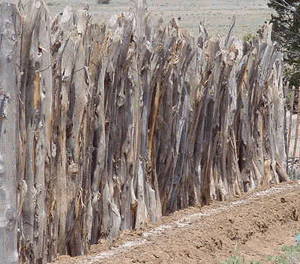
Coyote fencing made of juniper branches
What Coyote Fencing Can Teach Us About Piecing Things Together
by Frank and Vicky Giannangelo / Avant-Gardening/Growing Creativity
Looking out our bedroom window, I can see only a portion of the coyote fence we put up on the west side of the garden - meant to help ease the strong spring west winds that start about ten in the morning and blow until sunset. Originally, coyote fencing was just that: sticks and pieces of broken juniper put together to form a corral for the night protection of sheep by Navajo and Mexican sheepherders. Today, old juniper fence posts are used; those that have rotted off at ground level, once being eight feet, now reduced to six or less. Today it is also used for other purposes. One friend uses it to hide her propane tank down the hill - both from her view, and any neighbors across the field that may see the robin's egg blue color sitting amidst the sandstone hues. Another friend enclosed her small back yard, providing a certain containment and definition for a grassy area existing amid sandstone spires and multicolored cliffs.
Adverse conditions promote symbiotic relationships - most of the trees around us grow together, intertwined. The Pinon pine and the Juniper mingle, providing some component necessary to weather this environment. Hence, the juniper never grows really straight; it weaves and works its way around the Pinon. Most juniper (the wood that will last the longest) fence posts have at least two, if not three, bends, curves, and twists to them. The trick in using them for coyote fencing is to be able to adapt these curves to the posts on either side, creating a fence of continuity - with not too many wide gaps. I have had to turn a post upside down to make it fit!
A "partial perspective" is in many ways like building a coyote fence. We gathered all the old posts we could find and put them into a pile we could choose from to find the best post for the situation. Each one must "fit" - as well as possible - to the bends and curves of the others.
With the first leaf-erupting plants (radishes, lettuce, spinach, onions, beets, and carrots) we have a "partial perspective" of this year's garden. Whereas the perspective of the coyote fence from the bedroom window was rendered partial by trees, the view of the garden's final fruition is obscured by time. Each requires a step-by-step process to achieve the goal. No year in the growing season is ever the same, and the gardener must twist and turn to each new situation: the heat, the wind, the lack of rain, late or early frosts, and all the other events that appear during a growing season.
With the coyote fence, the adjustments are made visually. With a garden, adjustments are made with, and by - experience, knowledge, and information. Over the years of growing, we have accumulated many facts - things we know work. We have also read about more things than we have been able to put into practice, and we hold these as knowledge or ideas to be used when the need arises. We constantly run into information (in magazines, on television gardening shows, pamphlets, internet sites, etc.) that provides a link, or relationship, between all these accumulated facts. Just as we gathered the posts for the garden fence, we have provided the soil with nutrients, tilled it, and put on a layer of mulch. Some seeds have been planted, and some have germinated, and just as we adapted the twists and turns of the posts for the fence, we will twist and turn ourselves to grow a garden with that will also "fit". The season is ahead - you can grow!
Copyright (c) 2001
Avant-Gardening/Growing Creativity
Join our Avant-Gardening Interactive e-group at: http://www.egroups.com/group/avant-gardening
Post your own messages or articles, participate or create an Avant-Gardening Poll, chat on line with other members and gardening groups, ask questions, give answers, tell about your garden, post photos of your gardens, post your creative chapter to "Sowspurse" - an interactive cyber-story, and read all the back issues of Avant-Garden Tid-Bytes, and much more!
Virtually visit our New Mexico gardens at: http://photos.yahoo.com/giannangelo
- Frank and Vicky Giannangelo, Avant-Gardening/Growing Creativity,
Giannangelo Farms Southwest
RETURN TO OMPLACE HOME
